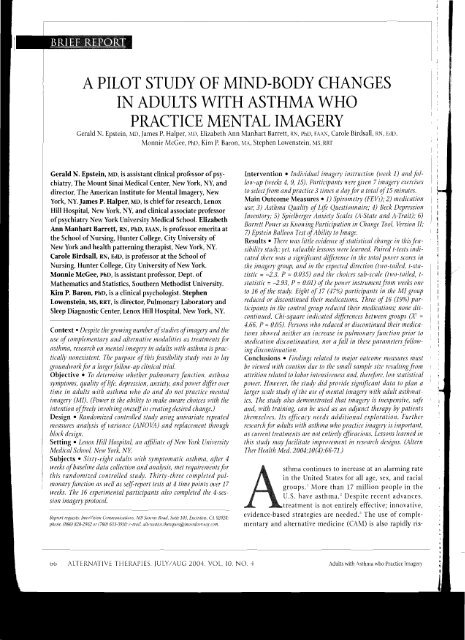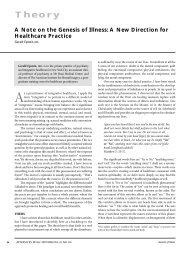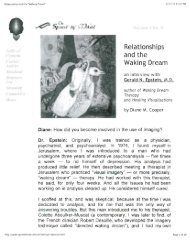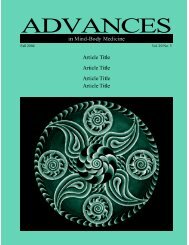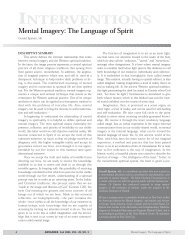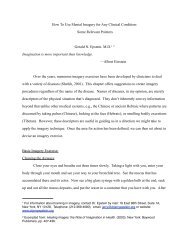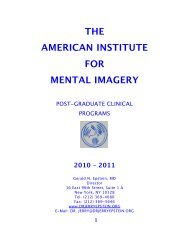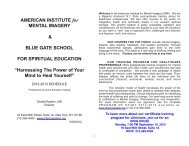a pilot study of mind-body changes in adults with ... - dr. jerry epstein
a pilot study of mind-body changes in adults with ... - dr. jerry epstein
a pilot study of mind-body changes in adults with ... - dr. jerry epstein
Create successful ePaper yourself
Turn your PDF publications into a flip-book with our unique Google optimized e-Paper software.
A PILOT STUDY OF MIND-BODY CHANGES<br />
IN ADULTS WITH ASTHMA WHO<br />
PRACTICE MENTAL IMAGERY<br />
Gerald N. Epste<strong>in</strong>, MD, James P. Halper, MD, Elizabeth Ann Manhart Barrett, RN. PhD, FAA};, Carole Birdsall, RN, EdD.<br />
Monnie McGee, PhD, Kim P. Baron, MA, Stephen Lowenste<strong>in</strong>, MS, RRT<br />
I<br />
Gerald N. Epste<strong>in</strong>, MD, is assistant cl<strong>in</strong>ical pr<strong>of</strong>essor <strong>of</strong>psy Intervention. Individual imagery <strong>in</strong>struction (week 1) and jiilchiatry,<br />
The Mount S<strong>in</strong>ai Medical Center, New York, NY, and low-up (weeks 4, 9, 15). Participants were given 7 imagery exercises<br />
director, The American Institute for Mental Imagery, New to selectfrom and practice 3 times a dayfor a total <strong>of</strong>15 m<strong>in</strong>utes.<br />
York, NY. James P. Halper, MD, is chieffor research, Lenox Ma<strong>in</strong> Outcome Measures • 1) Spirometry (FEV1); 2) medication<br />
Hill Hospital, New York, NY, and cl<strong>in</strong>ical associate pr<strong>of</strong>essor<br />
use; 3) Asthma Quality <strong>of</strong> Life Questionnaire; 4) Beck Depression<br />
Inventory; 5) Spielberger Anxiety Scales (A.-State and A-Trait); 6)<br />
<strong>of</strong>psychiatry New York University Medical School. Elizabeth<br />
Barrett Power as Anow<strong>in</strong>g Participation <strong>in</strong> Change Tool, Version II;<br />
Ann Manhart Barrett, RN, PhD, FAAN, is pr<strong>of</strong>essor emerita at<br />
7) Epste<strong>in</strong> Balloon Test <strong>of</strong>Ability to Image.<br />
the School <strong>of</strong>Nurs<strong>in</strong>g, Hunter College, City University <strong>of</strong><br />
Results • There was little evidence <strong>of</strong>statistical change <strong>in</strong> tllisfea<br />
New York and health pattern<strong>in</strong>g therapist, New York, NY. sibility studl'; yet, valuable lessons were learned. Paired t-tests <strong>in</strong>di<br />
Carole Birdsall, RN, EdD, is pr<strong>of</strong>essor at the School <strong>of</strong><br />
cateithere -w;s a significant difference <strong>in</strong> the total power scores <strong>in</strong><br />
Nurs<strong>in</strong>g, Hunter College, City University <strong>of</strong>New York.<br />
the imagery group, and <strong>in</strong> the expected direction (two-tailed, t-sta<br />
Monnie McGee, PhD, is assistant pr<strong>of</strong>essor, Dept. <strong>of</strong> tistic = -2.3, P = 0.035) and the choices sub-scale (two-tailed, t<br />
Mathematics and Statistics, Southern Methodist University. statistic = -2.93, P = 0.01) <strong>of</strong>the power <strong>in</strong>strumentfrom weeks one<br />
Kim P. Baron, PhD, is a cl<strong>in</strong>ical psychologist. Stephen<br />
to 16 <strong>of</strong> the <strong>study</strong>. Eight <strong>of</strong>17 (47%) participants <strong>in</strong> the MI group<br />
Lowenste<strong>in</strong>, MS, RRT, is director, Pulmonary Laboratory and reduced or discont<strong>in</strong>ued their medications. Three <strong>of</strong>16 (19%) par<br />
Sleep Diagnostic Center, Lenox Hill Hospital, New York, NY.<br />
ticipants <strong>in</strong> the control group reduced their medications; none discont<strong>in</strong>ued.<br />
Chi-square <strong>in</strong>dicated difJi'rences between groups (X =<br />
4.66, P = 0.05). Persons who reduced or discont<strong>in</strong>ued their medica<br />
Context· Despite the grow<strong>in</strong>g number <strong>of</strong>studies <strong>of</strong>imagery and the tions showed neither an <strong>in</strong>crease <strong>in</strong> pulmonary function prior to<br />
use <strong>of</strong> complementary and alternative modalities as treatments for medication discont<strong>in</strong>uation, nor afall <strong>in</strong> these parameters followasthma,<br />
research on mental imagery <strong>in</strong> <strong>adults</strong> <strong>with</strong> asthma is prac<strong>in</strong>g discont<strong>in</strong>uation.<br />
tically nonexistent. The purpose <strong>of</strong> this feasibility <strong>study</strong> was to lay Conclusions • F<strong>in</strong>d<strong>in</strong>gs related to major outcome measures must<br />
groundworkfor a largerfollow-up cl<strong>in</strong>ical trial.<br />
be viewed <strong>with</strong> caution due to the small sample size result<strong>in</strong>gfrom<br />
Objective • To determ<strong>in</strong>e whether pulmonary function, asthma attrition related to labor <strong>in</strong>tensiveness and, thercjiJrC, low statistical<br />
symptoms, quality <strong>of</strong>lifi', depression, anxiety, and power differ over power. However, the <strong>study</strong> did provide significant data to plan a<br />
time <strong>in</strong> <strong>adults</strong> <strong>with</strong> asthma who do and do not practice mental larger scale <strong>study</strong> <strong>of</strong>the use 4mental imagery <strong>with</strong> adult asthmatimagery<br />
(MI). (Power is the ability to make aware choices <strong>with</strong> the ics. The <strong>study</strong> also demonstrated that imagery is <strong>in</strong>expensive, safe<br />
<strong>in</strong>tention <strong>of</strong>freely <strong>in</strong>volv<strong>in</strong>g oneself<strong>in</strong> creat<strong>in</strong>g desired change.) and, <strong>with</strong> tra<strong>in</strong><strong>in</strong>g, can bt' ust'd as an adjunct therapy by patients<br />
Design • Randomized controlled <strong>study</strong> us<strong>in</strong>g univariate repeated tht'mselvt's. Its efficacy needs additional exploration. Further<br />
measures analysis <strong>of</strong> variance (ANOVA) and replacement through researchji)r <strong>adults</strong> <strong>with</strong> asthma who practice imagery is important,<br />
block design.<br />
as currCllt treatments are not entirely ejjiracious. Lessons learned <strong>in</strong><br />
Sett<strong>in</strong>g • Lenox Hill Hospital, an 4jiliate <strong>of</strong> New York University this <strong>study</strong> may facilitate improvement <strong>in</strong> research designs. (Altern<br />
Medical School. New York. NY Ther Health Med. 2004;10(4):66-71.)<br />
Subjects • Sixty-eight <strong>adults</strong> <strong>with</strong> symptomatic asthma, after 4<br />
weeks <strong>of</strong>basel<strong>in</strong>e data collection and analysis, met requirementsfor<br />
sthma cont<strong>in</strong>ues to <strong>in</strong>crease at an alarm<strong>in</strong>g rate<br />
this randomized controlled <strong>study</strong>. Thirty-three completed pul <strong>in</strong> the United States for all age, sex, and racial<br />
monary function as well as self-report tests at 4 time po<strong>in</strong>ts over 17<br />
groups.' More than 17 million people <strong>in</strong> the<br />
weeks. The 16 experimental participants also completed the 4-ses U.S. have asthma.' Despite recent advances,<br />
sion imagery protocol.<br />
treatment is not entirely effective; <strong>in</strong>novative,<br />
Repnnt requests: lnno Vision Communh'aliolls, 169 Saxon)' Koad, Suite 103, Enc<strong>in</strong>itas, C4 92024: evidence-based strategies are needed. J The use <strong>of</strong> complephone.<br />
(866) 828-2962 or (760) 633-3910; ,-mail, altmlotl
<strong>in</strong>g, partly because people want to be more powerful partners<br />
<strong>in</strong> their care.' Mental imagery (M!) is a CAM modality whereby<br />
people use the natural language <strong>of</strong> the <strong>m<strong>in</strong>d</strong> to create<br />
images that affect the <strong>body</strong>. The purpose <strong>of</strong> this <strong>study</strong> was<br />
to exam<strong>in</strong>e the efficacy <strong>of</strong> Ml to empower people to more<br />
effectively manage asthma symptoms and improve the quality<br />
<strong>of</strong> their lives.<br />
Research Questions<br />
The <strong>study</strong> team asked the follow<strong>in</strong>g questions:<br />
1. Do volume <strong>of</strong> air forced out <strong>of</strong> the lungs <strong>in</strong> one second<br />
(FEV 1 ) and Peak Expiratory Flow Rate (PEFR) differ<br />
over time <strong>in</strong> <strong>adults</strong> <strong>with</strong> asthma who do and do not<br />
practice mental imagery?<br />
2. Do depression, anxiety, quality <strong>of</strong> life, and power differ<br />
over time <strong>in</strong> <strong>adults</strong> <strong>with</strong> asthma who do and do not<br />
practice mental imagery?<br />
3. Do symptoms and "events" (relapses, major flares) differ<br />
over time <strong>in</strong> <strong>adults</strong> <strong>with</strong> asthma who do and do not<br />
use mental imagery?<br />
METHODS<br />
, Design<br />
This was a randomized controlled <strong>study</strong> us<strong>in</strong>g univariate<br />
repeated-measures analysis <strong>of</strong> variance (ANOVA). Random<br />
assignment to the imagery or no imagery group considered factors<br />
<strong>of</strong> sex, race, age, atopy, severity. treatment regimen, and<br />
smok<strong>in</strong>g; a block design was used.<br />
Inclusion and Exclusion Criteria<br />
Inclusion criteria <strong>in</strong>cluded: 1) one diagnosis <strong>of</strong> asthma<br />
confirmed by pulmonary function test<strong>in</strong>g; 2) ages 25-55; 3)<br />
ability to read, speak, and understand English.<br />
Exclusion criteria <strong>in</strong>cluded: 1) unstable medical conditions<br />
and/or conditions be<strong>in</strong>g treated <strong>with</strong> agents directly<br />
affect<strong>in</strong>g the nervous system; 2) psychotropic <strong>dr</strong>ugs for prior 6<br />
months: 3) psychiatric hospitalizations <strong>in</strong> last 2 years; 4) axis I<br />
psychiatric disorder; 5) asthma related hospitalizations <strong>in</strong> prior<br />
6 months; 6) FEV1< 50%; 7) significant irreversible airway<br />
, obstruction; 8) upper respiratory <strong>in</strong>fections <strong>with</strong><strong>in</strong> prior 6<br />
\leeks; 9) <strong>in</strong>novative anti-<strong>in</strong>flammatory agents such as<br />
methotrexate; 10) not at basel<strong>in</strong>e and requir<strong>in</strong>g immediate<br />
treatment alteration; and, 11) negative results on the Epste<strong>in</strong><br />
Balloon Screen<strong>in</strong>g Test for Imagery Ability."<br />
Instruments<br />
Instruments <strong>in</strong>cluded: 1) demographic <strong>in</strong>formation form:<br />
2) measurement <strong>of</strong> symptom <strong>in</strong>tensity us<strong>in</strong>g patient diaries: 3)<br />
measurement <strong>of</strong> airflow impairment <strong>in</strong>clud<strong>in</strong>g: a) peak expiratory<br />
flow rate us<strong>in</strong>g peak flow meters and recorded <strong>in</strong> diaries;<br />
: b) spirometry as measured by FEV 1 at basel<strong>in</strong>e and weeks 4, 10,<br />
and 16 <strong>in</strong> the hospital pulmonary laboratory; 4) medication<br />
use as determ<strong>in</strong>ed by quantitative change as well as <strong>changes</strong> <strong>in</strong><br />
the nature <strong>of</strong> the regimen (addition or subtraction) and recorded<br />
<strong>in</strong> diaries; 5) Asthma Quality <strong>of</strong> Life Questionnaire<br />
(AQLQ);"" 6) Beck Depression Inventory (BDI);'! 7)<br />
Spielberger Anxiety Scales (A-State; A-Trait);" 8) qualitative<br />
measurement <strong>of</strong> imagery ability us<strong>in</strong>g The Epste<strong>in</strong> Balloon<br />
Test"; and, 9) Barrett Power as Know<strong>in</strong>g Participation <strong>in</strong><br />
Change Tool, Version II (PKPCT). U H Internal consistency reliability<br />
<strong>of</strong> the AQLQ, BDl, PKPCT, A-State, and A-Trait were<br />
computed for week 1 and week 16 us<strong>in</strong>g Cronbach's alpha and<br />
ranged from 0.89 to 0.99 for the various <strong>in</strong>struments.<br />
Imagery Treatment Protocol<br />
Follow<strong>in</strong>g Institutional Review Board approval, participants<br />
who were randomized, after completion <strong>of</strong> pre-test<strong>in</strong>g<br />
and the basel<strong>in</strong>e period, to the imagery group were seen by a<br />
therapist tra<strong>in</strong>ed <strong>in</strong> imagery therapy at weeks 1, 4, 9, and 15 for<br />
imagery <strong>in</strong>struction and follow-up. Each participant was given 7<br />
imagery exercises to select from and practice three times a day<br />
for a total <strong>of</strong> 15 m<strong>in</strong>utes. Spirometry and paper-pencil test<strong>in</strong>g<br />
occurred one week after each <strong>of</strong> the 3 imagery follow-up visits.<br />
An example <strong>of</strong> one <strong>of</strong> the 7 standard imagery exercises is presented<br />
<strong>in</strong> Box 1. The control group received no <strong>in</strong>tervention.<br />
Sample Screen<strong>in</strong>g and Selection<br />
Participants were recruited through the hospital asthma<br />
cl<strong>in</strong>ic. newspaper advertisements, posted flyers, and word <strong>of</strong><br />
mouth. A sample size <strong>of</strong> 60 was proposed; 68 began and 33 f<strong>in</strong>ished.<br />
Therefore, the power to detect a moderate treatment<br />
effect at a 0.05 level <strong>of</strong> significance decreased from 0.8 to 0.35.<br />
Dur<strong>in</strong>g screen<strong>in</strong>g. ability to image was assessed us<strong>in</strong>g the qualitative<br />
Epste<strong>in</strong> Balloon Test. Participants were asked to close<br />
their eyes and imag<strong>in</strong>e see<strong>in</strong>g a box <strong>of</strong> colored balloons on a<br />
table and to take one out and blow it up." If unable to visualize<br />
<strong>in</strong> this imagery exercise, they were excluded. Persons <strong>with</strong> asthma<br />
were given pulmonary function tests (FEV I) <strong>in</strong> the hospital<br />
laboratory to confirm a diagnosis <strong>of</strong> asthma <strong>in</strong> the moderate or<br />
moderately severe categories def<strong>in</strong>ed by the National Asthma<br />
Expert Pane!'! A reduced FEV 1 , the volume <strong>of</strong> air forced out <strong>of</strong><br />
the lungs <strong>in</strong> one second, <strong>in</strong>dicates <strong>in</strong>creased airflow obstruction<br />
as seen <strong>with</strong> asthma. Scores are reported as percent <strong>of</strong> normal<br />
predicted for persons <strong>in</strong> a particular category <strong>of</strong> asthma<br />
severity. While 329 were <strong>in</strong>itially screened by phone, only 68<br />
I<br />
I<br />
B~ 1 E~pl" o[jm"", Exm'" I<br />
"Tak<strong>in</strong>g a Weight OffYour Chest"';<br />
Close your eyes and breathe out three times slowly. See and sense a I<br />
weight on and <strong>in</strong> your chest. Feel and sense the constriction it gives<br />
you. Breathe out one time slowly and remove this weight. See and<br />
sense your lungs expand<strong>in</strong>g and mUng <strong>with</strong> white Ught as you f<strong>in</strong>d<br />
your breath<strong>in</strong>g becom<strong>in</strong>g easy and flow<strong>in</strong>g. Then. open your eyes.<br />
(;--JOTE: In addition to its scheduled use, this exercise was to be done at any<br />
time chest constriction was sensed,)<br />
~ -<br />
,'-dults <strong>with</strong> Asthma who Practice Imagen' ALTERNATIVE THERAPIES, JULY/AUG 2004. VOL 10, NO.4 67
'I Lost<br />
---~ --~----<br />
--------------------------- -<br />
1------------------------ <br />
I<br />
I<br />
1------------ <br />
--,<br />
,--------------l<br />
I ' Excluded (J'\=261)<br />
H Not meet<strong>in</strong>g <strong>in</strong>clusion criteria (n=222) ,<br />
I, I Refused to participate (n=:'I9) J<br />
I,<br />
I Assessed for eligibility (N=329) J<br />
----~'-----<br />
I<br />
Randomized (N=68)<br />
I<br />
L , ----.J<br />
~------------i<br />
--------------"------------,<br />
I<br />
IAllocated to <strong>in</strong>tervention (n=34) , IAllocated to control group (n=34) l<br />
, Received a1located <strong>in</strong>tervention (n=34) I Received no <strong>in</strong>tervention (n=34)<br />
LDid not receive allocated <strong>in</strong>tervention (n=O) ~________ l __. ----,________ _J<br />
~------ I ~----<br />
to follow up (n=17) l Lost to follow up (n=16) I'<br />
Disconnected telephone/moved <strong>with</strong> no forward<strong>in</strong>g ad<strong>dr</strong>ess (11=:'1) I Disconnected telephone/moved <strong>with</strong> no forward<strong>in</strong>g ad<strong>dr</strong>ess (11=2)<br />
• Discont<strong>in</strong>ued <strong>in</strong>tervention/test<strong>in</strong>g due to time constra<strong>in</strong>ts, travel<br />
Discont<strong>in</strong>ued <strong>in</strong>tervention/test<strong>in</strong>g due to excessive requirements,<br />
~uireme~ts, lost <strong>in</strong>terest (11=14) wait to receive imagery at completion <strong>of</strong><strong>study</strong> was too long (11=14) I<br />
L<br />
- - -----.-1--------<br />
I<br />
' Analyzed (n=17)<br />
II<br />
I<br />
Excluded from analysis (n=O)<br />
~----<br />
Analyzed (n=16)<br />
I Excl~ded from analysis (n=O)<br />
L<br />
FIGURE 1 Flow Diagram <strong>of</strong> Participant Progress Through the Phases <strong>of</strong> a Randomized Study<br />
met requirements after complet<strong>in</strong>g 4 weeks <strong>of</strong> basel<strong>in</strong>e data ANOVA tests <strong>with</strong> FEVl as the dependent variable, weeks <strong>of</strong><br />
collection and pre-test<strong>in</strong>g.<br />
<strong>study</strong> as the repeated factor, and group membership as the<br />
between-groups factor show that differences between imagery<br />
Data Collection and control groups are not statistically significant (P = 0.35).<br />
Follow<strong>in</strong>g randomization, 17 participants completed 4 The change <strong>in</strong> mean FEVl value for the imagery group from<br />
imagery sessions over 16 weeks and 16 participants were <strong>in</strong> week 1 to week 16 is not cl<strong>in</strong>ically significant. Excessive miss<strong>in</strong>g<br />
the control group. The consort diagram, <strong>in</strong> Figure 1, tracks the data prevented conduct<strong>in</strong>g analyses for differences <strong>in</strong> PEFR.<br />
participants as they progressed through the <strong>study</strong>. Both The second research question asked, "Do depression, anxgroups<br />
cont<strong>in</strong>ued usual care <strong>with</strong> their physicians and com iety, quality <strong>of</strong> life, and power differ over time <strong>in</strong> <strong>adults</strong> <strong>with</strong><br />
pleted paper-pencil and laboratory tests at weeks 1, 4, 10, and asthma who do and do not practice mental imagery?" Us<strong>in</strong>g<br />
16. Us<strong>in</strong>g a block design for participant replacement, random univariate-repeated measures-ANOVA, there were no statistiization<br />
rema<strong>in</strong>ed <strong>in</strong>tact. Table 1 presents demographics, <strong>in</strong>di cally significant differences between groups for BDl, A-State, A<br />
cators <strong>of</strong> asthma severity, and screen<strong>in</strong>g test scores. The Trait, and AQLQ. The paired sample t-test that compared<br />
control group was <strong>of</strong>fered imagery sessions at the completion quality <strong>of</strong> life <strong>in</strong> week 1 <strong>with</strong> week 16 revealed a trend toward<br />
<strong>of</strong> the <strong>study</strong>.<br />
improvement <strong>in</strong> only the mental imagery group for the activity<br />
After 4 weeks <strong>of</strong> basel<strong>in</strong>e data collection, participants sub-scale (mean difference = 0.72: P= 0.06). Figure 2 presents a<br />
were scheduled for spirometry (FEV1) at week 1, 4, 10, and 16. graph that lists the mean raw total power scores for four time<br />
Dur<strong>in</strong>g these visits the AQLQ, BDl, A-Trait and the PKPCT periods and both treatment groups. Paired t tests for the<br />
were adm<strong>in</strong>istered. Participants were provided <strong>with</strong> diaries to imagery group compar<strong>in</strong>g week 1 <strong>with</strong> week 16 showed statistirecord<br />
symptoms, medication usage (<strong>in</strong>clud<strong>in</strong>g regimen cally significant f<strong>in</strong>d<strong>in</strong>gs <strong>in</strong> the expected direction. The scores<br />
<strong>changes</strong>), objective measures (PEFR morn<strong>in</strong>g and even<strong>in</strong>g), A for total power (awareness, choices, freedom to act <strong>in</strong>tentional<br />
State and BDI self reports, and frequency <strong>of</strong> practic<strong>in</strong>g ly, and <strong>in</strong>volvement <strong>in</strong> creat<strong>in</strong>g change) <strong>in</strong> the mental imagery<br />
imagery exercises.<br />
group were higher at the end <strong>of</strong> the <strong>study</strong> than at the beg<strong>in</strong>n<strong>in</strong>g<br />
(mean difference = -11.7; SD = 20.97; t-statistic = -2.3, P =<br />
RESULTS<br />
0.035). The control group scores were not statistically signifi<br />
Initial basel<strong>in</strong>e levels <strong>of</strong> all outcome variables were con cant (mean difference = 7.19, SD = 53.35, t-statistic = 0.539, P=<br />
trolled for <strong>in</strong> the analysis. The first research question asked, 0.538). The choices sub-scale scores <strong>of</strong> the PKPCT also<br />
"Do FEVl and PEFR differ over time <strong>in</strong> <strong>adults</strong> <strong>with</strong> asthma who <strong>in</strong>creased when a paired sample t-test compared differences<br />
do and do not practice mental imagery?" Repeated-measures- between week 1 and week 16 (mean difference = -4.65, SD =<br />
_<br />
A<br />
H<br />
RI<br />
Fi\<br />
En<br />
Vi~<br />
Ch<br />
(Ce<br />
AQ<br />
Stal<br />
Sen<br />
Trai<br />
Sen<br />
Dep<br />
6.54<br />
scan<br />
SD=<br />
"evel<br />
asthl<br />
signi<br />
for CI<br />
as vis<br />
68 ALTERNATIVE THERAPIES, JULY/AUG 2004 VOL 10. NO.4 Adults <strong>with</strong> ASlhma who Practice Imagery<br />
Adults
-<br />
TABLE 1 Demographic and other Characteristics (11=33)<br />
Characteristic Imagery (n=17) Control (n=16)<br />
Sex Female: 73%<br />
Male: 27%<br />
Female: 57'1('<br />
Male: 43%<br />
Race Caucasian: 76% Caucasian: 69%<br />
African American: 24% African American: 20%<br />
Hispanic: 0 Hispanic: 11%<br />
Smokers Yes: 31% Yes: 41%<br />
No: 69% No: 59%<br />
Allergies: Environmental Yes: 88% Yes: 80%<br />
Grasses, Animals, No: 12% No: 20%<br />
and/or Dust<br />
Allergies: Food Yes: 36% Yes: 29%<br />
No: 64% No: 71%<br />
Allergies: Medication Yes: 46% Yes: 34%<br />
No: 54% No: 66%<br />
History <strong>of</strong>Upper Yes: 76% Yes: 77%<br />
Respiratory Infections No: 24% 1\0: 23%<br />
Exacerbation from Yes: 52% Yes: 54%<br />
Exercise No: 48% No: 46%<br />
Five or Fewer Yes: 99% Yes: 88%<br />
Emergency Department No: 1% No: 12%<br />
Visits <strong>in</strong> Lifetime<br />
Chronic Oral Steroid Use WeekI: 2 WeekI: 3<br />
(Counts, Not Percents) Week 16: 0 Week 16: 2<br />
FEV1 at Screen<strong>in</strong>g 67.29 %(SO 17.35%) 69.86 % (SD 13.57%)<br />
: AQLQat Screen<strong>in</strong>g x= 134.96 (SO 32.20) 130.33 (SD 34.5)<br />
State Anxiety at x= 40.90 (SO 14.42) 39.86 (SD 13.28)<br />
Screen<strong>in</strong>g<br />
Trait Anxiety at x= 42.06 (SD 10.03) 41.48 (SD 13.56)<br />
Screen<strong>in</strong>g<br />
Depression at Screen<strong>in</strong>g X= 9.67 (SD 9.12) 8.24 (SO 7.18)<br />
6.54, [-statistic =- 2.931, P = 0.01). Aga<strong>in</strong>, the control group<br />
scores were not statistically significant (mean difference = 1.31,<br />
SD = 11.89, [-statistic = 0.442, P = 0.665).<br />
The third research question asked: "Do symptoms and<br />
"events" (relapses, major flares) differ over time <strong>in</strong> <strong>adults</strong> <strong>with</strong><br />
asthma who are and are not tra<strong>in</strong>ed <strong>in</strong> mental imagery?" No<br />
significant values were found for differences between groups<br />
for cough<strong>in</strong>g, wheez<strong>in</strong>g, activity, sleep or adverse events, such<br />
as visits to an emergency department.<br />
ADDITIONAL ANALYSES<br />
Discont<strong>in</strong>u<strong>in</strong>g or Decreas<strong>in</strong>g Medications<br />
Eight <strong>of</strong> the 17 (47%) MI participants reduced (n=4) or<br />
discont<strong>in</strong>ued (n=4) their medications. Three <strong>of</strong> the 16 (19%)<br />
control participants reduced their medications, but none discont<strong>in</strong>ued.<br />
Of the total group, 11 participants had a medication<br />
change and 22 had no medication change. A chi-square<br />
test <strong>of</strong> <strong>in</strong>dependence between treatment group and medication<br />
change was performed and <strong>in</strong>dicated the 2 groups were<br />
statistically different (X' = 4.66, P = 0.05). Fisher's exact-test<br />
<strong>in</strong>dicated that there might be an association between treatment<br />
group and medication change (P = 0.087). Despite the<br />
small cell sizes <strong>in</strong> the chi-square analysis, it is cl<strong>in</strong>ically significant<br />
that 4 participants us<strong>in</strong>g imagery discont<strong>in</strong>ued their<br />
medications. Participants who did discont<strong>in</strong>ue or decrease<br />
medications showed neither an improvement <strong>in</strong> pulmonary<br />
function prior to medication discont<strong>in</strong>uation nor a fall <strong>in</strong><br />
these parameters follow<strong>in</strong>g discont<strong>in</strong>uation. It is important to<br />
note that 5 participants were tak<strong>in</strong>g oral steroids at the beg<strong>in</strong>n<strong>in</strong>g<br />
<strong>of</strong> the <strong>study</strong> and 2 were tak<strong>in</strong>g oral steroids at the end <strong>of</strong><br />
the <strong>study</strong>. Of these, 2 were <strong>in</strong> the imagery group and both discont<strong>in</strong>ued<br />
oral steroids; 3 were <strong>in</strong> the control group and 1 discont<strong>in</strong>ued<br />
oral steroids.<br />
Completers versus Noncompleters<br />
Mann Whitney tests revealed no statistically significant<br />
differences between compieters versus non-compieters for<br />
scores on the BDI, PKPCT, and A-State or A-Trait Scales. For<br />
AQLQ total score and activity and emotional function<strong>in</strong>g subscale<br />
scores, those scor<strong>in</strong>g higher at screen<strong>in</strong>g or week 1 were<br />
more likely to complete the <strong>study</strong> (each <strong>with</strong> P = 0.02).<br />
DISCUSSION<br />
Inclusion <strong>of</strong> objective measures <strong>of</strong> health status <strong>in</strong> the current<br />
<strong>study</strong> was designed to ensure patient safety <strong>in</strong> the event<br />
that change <strong>in</strong> participants' perception <strong>of</strong> symptoms led to<br />
undetected disease progression and/or <strong>in</strong>appropriate neglect<br />
<strong>of</strong> somatic treatment. In addition, participants rema<strong>in</strong>ed <strong>in</strong><br />
treatment <strong>with</strong> the primary care and/or specialist physicians <strong>of</strong><br />
their choice dur<strong>in</strong>g the <strong>study</strong>.<br />
One possible explanation for not see<strong>in</strong>g an overall<br />
improvement <strong>in</strong> pulmonary function tests for the mental<br />
imagery group is that 8 <strong>of</strong> the 17 participants reduced or discont<strong>in</strong>ued<br />
their asthma medication. On the other hand, it is<br />
possible that imagery is only effective as an addition to medication<br />
treatment, even though those who changed their medication<br />
had more positive scores on several <strong>of</strong> the psychosocial<br />
measures. It should be noted that the imagery participants did<br />
not experience a significant decrease <strong>in</strong> FEV!. The sample was<br />
too small to compare FEVl <strong>of</strong> those who decreased or discont<strong>in</strong>ued<br />
medications <strong>with</strong> imagers who did not; this requires further<br />
exam<strong>in</strong>ation <strong>in</strong> future studies as does the long-term effects<br />
<strong>of</strong> discont<strong>in</strong>u<strong>in</strong>g steroids. Despite these caveats, 47% <strong>of</strong> the<br />
imagers did decrease or discont<strong>in</strong>ue medications and pul-<br />
Adults <strong>with</strong> Asthma who Practice Imagery ALTERNATIVE THERAPIES, JULY/AUG 2004, VOL. 10, NO.4 69
I<br />
I<br />
I<br />
280<br />
I I<br />
01<br />
...<br />
8270<br />
Vl<br />
-;<br />
'0<br />
Eo-<<br />
Eo-<<br />
U<br />
~<br />
;.::<br />
~<br />
260<br />
Group<br />
y<br />
_____<br />
~ Ima_ger _____ /<br />
~. (onlml /<br />
~ """""""""""'"<br />
'~<br />
250'*------~-----~--------1<br />
1 4 10 16<br />
Week <strong>of</strong>Study<br />
I FIGURE 2 Power as Know<strong>in</strong>g Participation <strong>in</strong> Change Tool (PKPCT)<br />
i Scores by Week <strong>of</strong> Study and Treatment Groups<br />
monary function neither <strong>in</strong>creased nor decreased prior to or<br />
follow<strong>in</strong>g medication <strong>changes</strong>. This is an important f<strong>in</strong>d<strong>in</strong>g as<br />
it might <strong>in</strong>dicate that mental imagery did enable the participants<br />
to ma<strong>in</strong>ta<strong>in</strong> their health status and simultaneously<br />
decrease or discont<strong>in</strong>ue medications. The necessity <strong>of</strong> adequate<br />
imagery tra<strong>in</strong><strong>in</strong>g <strong>with</strong> sufficient follow-up along <strong>with</strong> diligent<br />
adherence to imagery practice seems critical. With asthma, the<br />
effect <strong>of</strong> imagery is <strong>of</strong>ten experienced <strong>in</strong> the immediate relief <strong>of</strong><br />
symptoms when us<strong>in</strong>g imagery dur<strong>in</strong>g an attack or impend<strong>in</strong>g<br />
attack. This re<strong>in</strong>forces both the power <strong>of</strong> imagery as well as the<br />
power <strong>of</strong>the person to use the imagery process effectively.<br />
Some <strong>of</strong> the most positive f<strong>in</strong>d<strong>in</strong>gs were differences <strong>in</strong> the<br />
2 groups related to power. Imagery appears to be a means to<br />
enhance power <strong>in</strong> persons <strong>with</strong> asthma. Outcomes from the<br />
qualitative arm <strong>of</strong> the <strong>study</strong>, reported elsewhere, provided<br />
stronger evidence that power was enhanced <strong>in</strong> experimental<br />
participants.!5 For example, participants reported that the<br />
daily imagery regimen opened up possibilities for active participation<br />
<strong>in</strong> their treatment by <strong>of</strong>ten prevent<strong>in</strong>g or abort<strong>in</strong>g<br />
dangerous asthma attacks, allow<strong>in</strong>g them to feel safe, secure,<br />
and powerful.!5<br />
IMPLICATIONS FOR FUTURE RESEARCH<br />
Consider<strong>in</strong>g that 8 participants <strong>in</strong> the mental imagery<br />
group decreased or went <strong>of</strong>f their medications compared <strong>with</strong><br />
only 3 <strong>in</strong> the control group who decreased medications, the<br />
lack <strong>of</strong> differences <strong>in</strong> FEVl between the 2 groups takes on new<br />
mean<strong>in</strong>g and warrants future <strong>in</strong>vestigation. The data suggest<br />
that further exploration <strong>of</strong> the power variable be considered <strong>in</strong><br />
future research s<strong>in</strong>ce total power scores (P = 0.04) and the<br />
choices sub-scale scores (P = 0.01) <strong>in</strong>creased from week 1 to<br />
week 16. There seemed to be an <strong>in</strong>teraction between time and<br />
'l<br />
mean total PKPCT scores between the two groups. For both<br />
groups, the major change was between week 10 and 16, but <strong>in</strong><br />
opposite directions. Both the importance <strong>of</strong> quality <strong>of</strong> life for<br />
persons <strong>with</strong> asthma and the f<strong>in</strong>d<strong>in</strong>gs from this <strong>study</strong> suggest<br />
further exploration <strong>of</strong> the relationship <strong>of</strong> imagery and quality<br />
<strong>of</strong> life, as well as the potential for the AQLQ to predict <strong>study</strong><br />
completion. In future research, control for effect <strong>of</strong> additional<br />
time spent <strong>with</strong> experimental participants must be <strong>in</strong>stituted<br />
along <strong>with</strong> long-term follow-up.<br />
LESSONS LEARNED<br />
The design for this <strong>study</strong> was too complex for the budget<br />
<strong>of</strong> $30,000. There were <strong>in</strong>sufficient funds for advertis<strong>in</strong>g.<br />
Recruitment <strong>of</strong> participants was much more difficult than orig<strong>in</strong>ally<br />
anticipated. This was likely due to excessively restrictive<br />
<strong>in</strong>clusion-exclusion criteria. Resources allow<strong>in</strong>g for adequate<br />
stafftime for follow up phone calls to both groups is also essential.<br />
The labor <strong>in</strong>tensiveness <strong>of</strong> the <strong>study</strong>, along <strong>with</strong> lack <strong>of</strong><br />
monetary remuneration, undoubtedly contributed to the 51%<br />
attrition; many participants who <strong>dr</strong>opped out verbalized this.<br />
In addition, data kept <strong>in</strong> diaries, such as measurements from<br />
peak flow meters, was <strong>of</strong>ten miss<strong>in</strong>g and therefore not available<br />
for analysis. We learned that it is necessary to solicit only critical<br />
<strong>in</strong>formation, preferably by phone calls from <strong>study</strong> personnel<br />
to both groups, and that it is not necessary for participants<br />
to have such frequent pulmonary function tests. Paper-andpencil<br />
tests could be completed at home and sent <strong>in</strong> by mail,<br />
thereby, requir<strong>in</strong>g fewer <strong>in</strong>-person visits. Although all <strong>in</strong>struments<br />
were reliable, the depression and anxiety scales did not<br />
seem to add mean<strong>in</strong>gful <strong>in</strong>formation and could be elim<strong>in</strong>ated<br />
to relieve participant burden. Imagery could be re<strong>in</strong>forced by<br />
use <strong>of</strong> an audiotape, thus decreas<strong>in</strong>g the number <strong>of</strong> <strong>in</strong>-person<br />
sessions. F<strong>in</strong>d<strong>in</strong>gs from this <strong>study</strong> are be<strong>in</strong>g used to design a<br />
larger randomized controlled <strong>study</strong>.<br />
CONCLUSIONS<br />
The fact that there was little evidence <strong>of</strong> statistical change<br />
<strong>in</strong> this <strong>study</strong> may be attributable to the lack <strong>of</strong> statistical power<br />
to detect differences <strong>in</strong> the data because <strong>of</strong> the small sample<br />
size. These prelim<strong>in</strong>ary data can facilitate power and sample<br />
size calculations for a larger <strong>study</strong>. Future <strong>study</strong> designs can be<br />
enhanced us<strong>in</strong>g the lessons learned from this <strong>study</strong>, particularly<br />
<strong>with</strong> regard to facilitat<strong>in</strong>g sample recruitment and participant<br />
retention.<br />
It was demonstrated that <strong>adults</strong> <strong>with</strong> asthma can learn to<br />
use mental imagery, sometimes <strong>with</strong> immediate relief <strong>of</strong> symptoms,<br />
and that mental imagery is safe, cost-effective, always<br />
available, and it requires little time to use. Some <strong>of</strong> these very<br />
prelim<strong>in</strong>ary f<strong>in</strong>d<strong>in</strong>gs suggest that imagery may make a positive<br />
difference <strong>in</strong> lives <strong>of</strong> asthmatics. S<strong>in</strong>ce current treatments are<br />
not completely efficacious, <strong>in</strong>vestigators are <strong>in</strong>vited to further<br />
research the effectiveness <strong>of</strong>mental imagery <strong>in</strong> the treatment <strong>of</strong><br />
<strong>adults</strong> <strong>with</strong> asthma.<br />
:-0 ALTERNATIVE THERAPIES. JULY/AUG 2004. VOL. 10, NO.4 Adults <strong>with</strong> Asthma who Practice Imagery Adul
II Acknowledgments<br />
This publication \yas made possible <strong>in</strong> part by a grant from the ~ational Center for<br />
I<br />
II<br />
Complementary & Alternative Medic<strong>in</strong>e C,CCA:>I) <strong>of</strong> the :\ational Institutes <strong>of</strong> Health<br />
(NIH). Pr<strong>in</strong>cipal Investigator james Halper, MD. Chieffor Research, Lenox Hill Hospital.<br />
)Jew York, NY. Its contents are solely the responsibility <strong>of</strong> the authors and do not nece ...<br />
sarily represent the views <strong>of</strong>:\CCA:Vl.<br />
References<br />
1. ~ational Heart. Lung, and Blood Institute C'\HLBIl. Expert Palit! Report 2:<br />
I,<br />
Guidel<strong>in</strong>es for the diagnosis and management (~rasthma. Bethe ...da. \1D, :\IH<br />
Publication ~o. 97-4051, 1997.<br />
2. National Heart, Lung, and Blood Institute (:\HLBIl. Data Fact Sheet: Asthlllil<br />
Statistics. Bethesda. MD, NIH Publication No. #55-798,1998.<br />
3. Healthv People 2010: The Surgeon General's Report. Stock No. 017-001-00547-9.<br />
Pittsburgh, PA: U.S. Government Pr<strong>in</strong>t<strong>in</strong>g Office. hltp:!hnm.health.gov/; 2000.<br />
4. Ast<strong>in</strong> JA. \Vhy patients use alternative medic<strong>in</strong>e: Results <strong>of</strong> a national <strong>study</strong>.<br />
lAMA. 1998; 279(19):1548-1553.<br />
5. Epste<strong>in</strong> G. The image <strong>in</strong> medic<strong>in</strong>e. Ad" M<strong>in</strong>d-Bod" Med. 1986: 3(1): 22-31.<br />
6. Epste<strong>in</strong> G. Heal<strong>in</strong>g l'isualizatio115: Creat<strong>in</strong>g Health Through Imagery. ~ew York:<br />
Bantam Books; 1989.<br />
7. Epste<strong>in</strong> G. Heal<strong>in</strong>g <strong>in</strong>to Immortality: A New Spiritual ,\;[t'dic<strong>in</strong>e (!f Ht'tl1ilzg Stories and<br />
llllagery. ~ew York: Bantam Books; 1994.<br />
8. Barrett EAM. Innovative imagery: A health pattern<strong>in</strong>g modality for nurs<strong>in</strong>g practice.<br />
! Holis Nurs.1992: 10(2): 154-165.<br />
9. juniper EF, Guyatt G. Evaluation <strong>of</strong> impairment <strong>of</strong> health related quality <strong>of</strong> life <strong>in</strong><br />
asthma: Development <strong>of</strong> a questionnaire for use <strong>in</strong> cl<strong>in</strong>ical trials. Thorax. 1992;<br />
47(2): 76-83.<br />
10. juniper EF, Buist, AF, Cox F, Ferrie P, K<strong>in</strong>g D. Yalidation <strong>of</strong> a standardized version<br />
<strong>of</strong> the asthma qualitv <strong>of</strong> lit;, questionnaire. Chest. 1999; 125(5): 1265-1270.<br />
11. Beck AT, Steer RA, Garb<strong>in</strong> MG. Psychometric properties <strong>of</strong> the Beck Depression<br />
Inventory: Twenty-five years <strong>of</strong> evaluation. ClIIl Psych ReI'. 1988; 8(1): 77-100.<br />
12. Spielberger CD, Edwards CD. Lushene RE. Mallual for the state-trait im'entory (self<br />
evaluation questionnaire). Palo Alto. CA: Consult<strong>in</strong>g Ps:'chologists Press; 1970.<br />
13. Barrett EAM. Update on a measure <strong>of</strong> power as know<strong>in</strong>g participation <strong>in</strong> change.<br />
In 0 Strickland, C Dilorio (Eds), Measurement o[Nurs<strong>in</strong>g Out",mes (2nd ed.): \'013:<br />
Self Care and Cop<strong>in</strong>g. I\'ew York: Spr<strong>in</strong>ger; 2003: 21-39.<br />
14. Caroselli C, Barrett EAM. A review <strong>of</strong> the pmver as knmv<strong>in</strong>g participation <strong>in</strong><br />
change literature. Nurs Sci Q. 1998; 11(1): 9-16.<br />
15. Epste<strong>in</strong> G, Barrett EAM, Halper jP, SeriffN, Phillips K & Lowenste<strong>in</strong> S. Alleviat<strong>in</strong>g<br />
asthma <strong>with</strong> mental imagery: A phenomenologic approach. A/t & Camp Thera.<br />
1997; 3(1): 42-52.<br />
Dr. Ohhira's Probiotics 12 PLUS<br />
NEXT GENERATION PROBIOTICS FROM JAPAN<br />
Only Probiotic Formulated to<br />
Target Deadly "Smart-Bugs"<br />
Methicill<strong>in</strong>-resistant<br />
Staphylococcus aureus (MRSA)<br />
H. pylori • E. coli 0157 • More<br />
(University-Based Research Available)<br />
SIX TIMES STRONGER THAN OTHER PROBIOTICS<br />
CROHN'S • ACID REFLUX • ASTHMA • DIABETES • ISS<br />
ARTHRITIS • HEPATITIS B & C • CANDIDA. ECZEMA<br />
12 Stra<strong>in</strong>s Live Lactic Acid Bacteria<br />
Award-W<strong>in</strong>n<strong>in</strong>g TH10 Stra<strong>in</strong> <strong>of</strong> LAB<br />
4 Organic Acids • Naturally Developed FOS<br />
Natural Bacterioc<strong>in</strong>s & Hy<strong>dr</strong>ogen Peroxide<br />
Vitam<strong>in</strong>s, M<strong>in</strong>erals & Am<strong>in</strong>o Acids<br />
5-Year Natural Temperature Fermentation<br />
Enteric Coated • Vegetarian Product<br />
3-Year Shelf Life • Refrigeration Not ReqUired<br />
Formulated by Award-W<strong>in</strong>n<strong>in</strong>g Microbiologist<br />
Iichiroh Ohhira, Ph.D.<br />
Japanese Plant Seeds Oil<br />
Omega-], 6 & 9 EFAs<br />
EVER WONDER WHY So MANY JAPANESE GET THEIR<br />
EFA's FROM PLANT SEED OILS NOT FISH OIL?<br />
THE ANSWER...<br />
FISH OIL CONTAINS HAZARDOUS CONTAMINANTS<br />
PESTICIDES. DDT. LINDANE. PCBs<br />
... EFAs From Oils <strong>of</strong> 7 Natural Plant Seeds Us<strong>in</strong>g<br />
"Cold-Extract" Process to Preserve Natural<br />
Properties and Qualities <strong>of</strong> the Plant Seeds...<br />
GREEN TEA. AVOCADO. FLAX. OLIVE<br />
CORN • RICE • SUNFLOWER<br />
3-Year Shelf Life. Refrigeration Not Required<br />
Guaranteed Free <strong>of</strong> Pesticides & Contam<strong>in</strong>ants<br />
EFAs In Comb<strong>in</strong>ation • Special Encapsulation<br />
The Food and Drug Adm<strong>in</strong>istration has not evaluated this<br />
statement, This product is not <strong>in</strong>tended to diagnose, treat,<br />
cure, or prevent any disease.<br />
Adults <strong>with</strong> Asthma who Practice Imagery<br />
Essential Formulas Incorporated<br />
1012 McCoy Drive • Irv<strong>in</strong>g, TX 75062-8005<br />
972 255-3918 • 972 255-6648 Fax. <strong>in</strong>fo@EssentiaIFormulas.com


